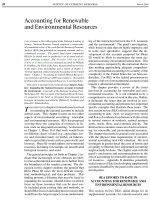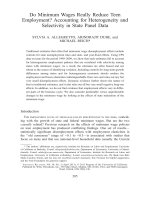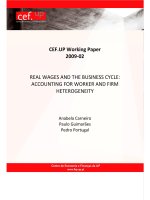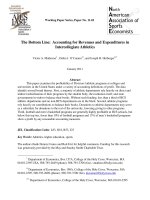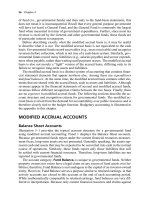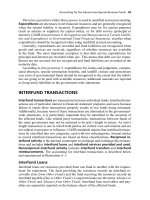1 ACCOUNTING FOR SALES AND EVALUATING BUSINESS RESULTS AT MAI DUONG 38 TRADING JOINT STOCK
Bạn đang xem bản rút gọn của tài liệu. Xem và tải ngay bản đầy đủ của tài liệu tại đây (4.56 MB, 147 trang )
MINISTRY OF FINANCE
ACADEMY OF FINANCE
STUDENT : TRAN THI THU
CLASS
: CQ 55/21.04
GRADUATION THESIS
TOPIC:
“ACCOUNTING FOR SALES AND EVALUATING BUSINESS
RESULTS AT MAI DUONG 38 TRADING JOINT STOCK”
Major
: Business Accounting
Student code
: 17523403010168
Supervisor
: PhD.Bui Thi Hang
Hanoi - 2021
Academy of Finance
Graduation Thesis
DECLARATION
I hereby declare that this thesis is my own work and effort that has not been
submitted anywhere for any award. Where other sources of information have been
used, they have been acknowledged.
The data and results described in the thesis are derived from the actual
situation of the practice company.
Hanoi,
May, 2021
Student
TRAN THI THU
Tran Thi Thu
1
CQ55/21.04
Academy of Finance
Graduation Thesis
TABLE OF CONTENT
DECLARATION................................................................................................i
TABLE OF CONTENT....................................................................................ii
Figure 2.1:Managing system of the Mai Duong 38., JSC company........ix
PREAMBLE......................................................................................................1
CHAPTER 1......................................................................................................4
BASIC THEORETICAL ISSUES OF SALES ACCOUNTING AND
DETERMINATION OF BUSINESS RESULTS..............................................4
1.1. General overview of sales accounting and determining business results
.......................................................................................................................4
1.1.1. Sales definition................................................................................4
1.1.2. The definition of business results....................................................4
1.1.3 The relationship between sales and determination of business
results........................................................................................................5
1.1.4.Accounting requirements for sales and dertermining business
results........................................................................................................5
1.1.5. The roles of sales accounting and determining business results....6
1.1.6. Sale accounting’duties and determining business results...............6
1.2. Basic content of sales accounting and determing business results.........7
1.2.1. Sale methods...................................................................................7
1.2.2. Payment method..............................................................................8
1.2.3. Sale accounting and determining business results..........................9
1.2.4.Accounting books are used for accounting for sale and evaluating
business results and to present information on financial statements.......32
1.2.4.1.Accounting books are used for accounting for sale and
evaluating business results......................................................................32
In each enterprise, each form of accounting book has specific regulations
on the number, structure, form, order, recording method and relationship
between accounting books. Depending on the size and characteristics of
each enterprise's business activities, it is necessary to choose an
appropriate accounting form, but still have to comply with the
regulations of the applicable circular......................................................32
Tran Thi Thu
2
CQ55/21.04
Academy of Finance
Graduation Thesis
*General Journal Form............................................................................32
- Basic features: All arising economic and financial transactions must be
recorded in the Journal, with the focus being on the General Journal, in
the chronological order of arising and according to the economic content
(accounting clauses) of the Company major. Then take data on the
Journal books to record in the ledger according to each arising
transaction...............................................................................................32
-General Journal Form includes the following types of books:..............32
+ General Journal....................................................................................32
+ Accounting Ledger...............................................................................32
+ Detailed accounting books and cards;..................................................32
*Journal-Ledger form..............................................................................32
-Basic features: All arising economic transactions reflected on
accounting vouchers are recorded in the only general accounting book,
which is the Journal - the ledger in chronological order. Based on the
Journal - ledger is the accounting vouchers or the Summary of
accounting vouchers of the same type.....................................................32
-Journal-Ledger form includes the following types of books:................32
+ Journal-Ledger.....................................................................................32
+ Cash book.............................................................................................32
+ The same Summary of documents.......................................................32
+ Advanced composite panel...................................................................32
*The form of recording vouchers:...........................................................32
-Basic features: The direct basis for recording general accounting books
is "booking vouchers". General accounting entries include:...................33
+ Record in chronological order on the Register of Recording
Documents...............................................................................................33
+ Record according to economic content on the Ledger.........................33
+ Bookkeeping vouchers prepared by accountants on the basis of
accounting vouchers or a summary of accounting vouchers of the same
type with the same economic content.....................................................33
+ Book-entry vouchers are numbered consecutively for each month or
whole year (according to the ordinal number in the Book of
Tran Thi Thu
3
CQ55/21.04
Academy of Finance
Graduation Thesis
Bookkeeping Documents) and accompanied by accounting vouchers,
which must be approved by the chief accountant before making
accounting entries....................................................................................33
-The form of recording vouchers includes the following types of books:
.................................................................................................................33
+ Recording vouchers; Register of book-keeping vouchers;..................33
+ Detailed accounting books and cards;..................................................33
*Document diary form:...........................................................................33
-Basic features:........................................................................................33
+ Gather and systematize the economic transactions arising under the
Credit side of the accounts combined with the analysis of those
economic transactions according to the Debit counterpart accounts......33
+ Closely combine the recording of economic transactions arising in
chronological order with the systematization of transactions according to
economic content (by account)...............................................................33
+ Combine widely general accounting with detailed accounting on the
same accounting book and in the same recording process......................33
+ Using pre-printed book templates for controlling accounts, economic
and financial management indicators and making financial statements
(forms of accounting entries)..................................................................33
-Document diary form includes the following types of books :..............33
+ Document dỉay.....................................................................................33
+ List table...............................................................................................33
+ Accounting ledger................................................................................34
+Detailed accounting books or cards;.....................................................34
1.2.4.2. Present information on financial statements..............................34
* On Accounting balance sheet:..............................................................34
-Acc 111,112 is shown on the cash and cash equivement.......................34
- Acc 156 is shown on Inventrories.........................................................34
- Acc 131 is shown on Current trade receivables....................................34
- Acc 133 is shown on Deduction VAT...................................................34
-Acc 331 is shown on the Current trade payables...................................34
Tran Thi Thu
4
CQ55/21.04
Academy of Finance
Graduation Thesis
- Acc 333 is shown on the Taxes and payables to the State....................34
* On the the business results report :.......................................................34
1.2.5.Accounting for sales and determining business results in terms of
applying software with pre-set programs................................................34
CONCLUSION CHAPTER 1.........................................................................37
CHAPTER 2:THE CURRENT SITUATION OF SALES ACCOUNTING
AND DETERMINATION OF BUSINESS RESULTS AT MAIDUONG 38
TRADING JOINT STOCK COMPANY........................................................38
2.1. Overview of Mai Duong 38 Trading Joint Stock.................................38
2.1.1. The process of information and development of Mai Duong 38
Trading Joint Stock Company.................................................................38
2.1.2. Business organization characteristic at the company....................39
2.1.3. Organizational and managerial charateristic at the company........39
Figure 2.1:Managing system of the Mai Duong 38., JSC company.......39
2.1.4. Characreristic of the organization of the accounting work at the
company..................................................................................................40
2.2. Accounting For sales and determination of business results at Mai
Duong 38.,JSC.............................................................................................48
2.2.1. Method of sale and types of goods................................................48
2.2.2. Principles of goods valuation........................................................50
2.2.3. Accounting for sales and determination of business results at Mai
Duong 38.,JSC.........................................................................................51
2.3. Evaluation of sales accounting and determination of business results at
Mai Duong 38 .,JSC....................................................................................99
2.3.1. Strength.........................................................................................99
2.3.2.Weakness and the limitations.......................................................100
CHAPTER 3: SOME COMMENTS OF FINISHING SALES
ACCOUNTING AND FINDING BUSINESS RESULT AT MAI DUONG
38., JSC.........................................................................................................103
3.1. Requirements, principles of completing accounting for sales and
evaluating business results at Mai Duong 38., JSC...................................103
3.1.1. Requirements...............................................................................103
Tran Thi Thu
5
CQ55/21.04
Academy of Finance
Graduation Thesis
3.1.2. Principles of completing accounting for sales and evaluating
business results......................................................................................104
3.2. Some recommendations to improve the accounting of sale and
evaluating business result at Mai Duong 38., JSC....................................105
3.3. Conditions for implementing the solution..........................................121
CONCLUDE.................................................................................................123
REFERENCES..............................................................................................125
Tran Thi Thu
6
CQ55/21.04
Academy of Finance
Graduation Thesis
LIST OF ABBREVIATIONS
Acc- Account
COGS – Cost of goods sold
Cr- Credit
Dr- Debit
FIFO- Fist- in First-out
Mai Duong 38.,JSC- Mai Duong 38 Trading Joint Stock Company
VAT- Value Added Tax
Tran Thi Thu
7
CQ55/21.04
Academy of Finance
Graduation Thesis
LIST OF DIAGRAM
Flowchart 1 - Accounting for COGS in the perpetual inventory method
Flowchart 2 - Accounting for COGS in the periodical inventory
method
Flowchart 3 – Accounting entry for sales, service provision
calculated VAT by deduction method
Flowchart 4: Accounting entry for revenue deductions
Flowchart 5:Accounting entry for selling expenses
Flowchart 6:Accounting entry for administrative expenses
Flowchart 7– Accounting entry for other income
Flowchart 8– Accounting entry for other expenses
Flowchart 9– Accounting entry for financial income.
Flowchart 10– Accounting entry for financial expenses
Flowchart 11– Accounting entry for corporate income tax
Flowchart 12– Accounting entry for business results
Tran Thi Thu
8
CQ55/21.04
Academy of Finance
Graduation Thesis
LIST OF FIGURES –DOCUMENTARY
Figure 2.1:Managing system of the Mai Duong 38., JSC company
Figure 2.2: The organizational chart of the accounting appartment at Mai Duong
38.,JSC.
Figure 2.3: Display screen “ FPT E-invoices”- “Mai Duong 38.,JSC”source
Figure 2.4: Accounting process on Misa.2017 software
Figure 2.5 Display screen “ MISA.2017”- “Mai Duong 38.,JSC”source
Figure 2.6: Code the goods- “Mai Duong 38.,JSC”source
Figure 2.7: List of materials and goods - “Mai Duong 38.,JSC”source
Figure 2.8: VAT invoice No.0000092 - “Mai Duong 38.,JSC”source
Figure2.9: Delivery note No.BH00354 - “Mai Duong 38.,JSC”source
Figure 2.10: Input screen- “Mai Duong 38.,JSC”source
Figure2.11: The Detail book of Account 5111- “Mai Duong 38.,JSC”source
Figure 2.12: The Ledger of Acc.511- “Mai Duong 38.,JSC” source
Figure 2.13: The Detail book of Account 131- “Mai Duong 38.,JSC”source
Figure 2.14: The Ledger of Account 3331- “Mai Duong 38.,JSC”source
Figure 2.15: The Credit note- “Mai Duong 38.,JSC”source
Figure 2.16: The Input screen- “Mai Duong 38.,JSC”source
Figure2.17: The Ledger of Account 112 in 2020- “Mai Duong 38.,JSC”source
Figure 2.18: The screen caculates the cost of goods sold- “Mai Duong
38.,JSC”source
Figure2.19: The Delivery report No.XK00508- “Mai Duong 38.,JSC”source
Figure 2.20: The Leger of Account 632- “Mai Duong 38.,JSC”source
Figure2.21: The Leger of Account 156- “Mai Duong 38.,JSC”source
Figure 2.22: The General inventory in 2020- “Mai Duong 38.,JSC”source
Figure2.23: The VAT Invoice- “Mai Duong 38.,JSC”source
Figure 2.24: The Cash payment voucher No. PC00182 “Mai Duong 38.,JSC”source
Figure.25: The input screen of Selling expenses- “Mai Duong 38.,JSC”source
Figure2.26: The Leger of Ac.111 in 2020- “Mai Duong 38.,JSC”source
Tran Thi Thu
9
CQ55/21.04
Academy of Finance
Graduation Thesis
Figure 2.27: The Leger of Ac.6421 in 2020- “Mai Duong 38.,JSC”source
Figure 2.28: The VAT invoice in 2020- “Mai Duong 38.,JSC”source
Figure2.29: The Input screen of adminnistrative expenses in 2020-“MaiDuong 38.,
JSC”source
Figure 2.30: The Ledger of Ac.6422 in 2020-“MaiDuong 38., JSC”source
Figure 2.31: The Detail book of Ac.331-Nguyen Hoang Joint Stock Company in
2020-“MaiDuong 38., JSC”source
Figure 2.32: The Input screen of Ac.515 in 2020-“MaiDuong 38., JSC”source
Figure2.33: The Ledger of Ac.515 in 2020-“MaiDuong 38., JSC”source
Figure 2.34: The Tranfering screen in 2020-“MaiDuong 38., JSC”source
Figure 2.35: The Ledger of Acc.911 in 2020-“MaiDuong 38., JSC”source
Figure2.36: The Ledger of Acc.4212 in 2020-“MaiDuong 38., JSC”source
Figure 2.37: The General journal in 2020-“MaiDuong 38., JSC”source
Figure 2.38: The screen of Financial statemen on HTKK Software t in
2020-“MaiDuong 38., JSC”source
Figure 2.39: The Icome Statement in 2020-“MaiDuong 38., JSC”source
Tran Thi Thu
10
CQ55/21.04
Academy of Finance
Graduation Thesis
PREAMBLE
1. The urgency of the topic
Our country is transforming in a period of renewal, fields of life - economy
- society are gradually being improved. In the near few years, our country has gone
up with quite obvious results, the relatively fast economic growth rate is operated
under the market mechanism under the management of the State and the life. The
people are gradually improved and enhanced. Along with the innovation process,
the first issue is how to best the profitability of the business, to know that, the
accounting department of the business must determine the profitability of the
business. Therefore, in order to quickly and accurately determine the realized profit
in the period, it requires that the accounting work must be complete and timely.
Therefore, accounting for sales and evaluating business results is a very important
job in the accounting system of the business. All activities, all transactions arising in
the enterprise are recorded to determine the business results.
Currently, information about business results is very important because on
this basis, managers can know whether their business processes are effective or not.
From there, they will make decisions regarding development orientation in the
future .
Therefore, it is required that economists, entrepreneurs, companies ... with a
professional accounting system must be flexible, dynamic, have been high
professional qualifications to lead the business to operate effectivily. Enterprises
must know to make full use of their abilities and strength to always master every
opportunity, have business development strategies, develop products in line with the
industry that they have been following chase. The ultimate goal of businesses is to
maximize profits. If you want to know whether your business is operating
effectively or not, you must rely on accounting and accounting for business results.
From there, accounting for income and distributing income to all economic sectors,
all production and business activities of their units help diversify production growth the State economy and meet the general needs of all society.
Tran Thi Thu
1
CQ55/21.04
Academy of Finance
Graduation Thesis
Accounting is an important component of the system of economic and
financial management tools. It provides all information about the economic and
financial activities of the business to help business leaders operate and manage the
operation of the rule with high efficiency. Accounting for determining business
results is one of the important tasks of accountants to help enterprises grasp the
efficiency of their business operations. At the same time, it will bring benefits in
organizing, operating and managing all production and business activities of the
enterprise in the future.
Indeed, in order to see the importance of the accounting system in general
and sales accounting and to determine the business results in particular, I have
chosen the topic for my graduate thesis is “Accounting for sales and evaluating
business results at Mai Duong 38 Trading Joint Stock Company”.
2. Research purposes
Firstly: systematize the theoretical issues of sales accounting and determine
business results in the business.
Secondly: find out the current status of sales accounting and determine
business results at Mai Duong 38 Trading Joint Stock Company.
Finnally: propose some solutions to improve sales accounting and determine
business results at Mai Duong 38 Trading Joint Stock Company.
3. Object and scope of the study
Sales accounting and determination of business results at Mai Duong Trading
Joint Stock Company 38 in the fourth quarter of 2020.
4. Research Methodology
To complete this topic, I used the following research methods:
- Research method, refer to documents: Read, refer, learn the textbooks
compiled by lecturers to teach; books in the library and learning resource center as a
basis for the research topic.
- Interview method: Used during the internship, help me answer my questions
and understand better about sales accounting and determine business results at the
company, thereby also help me accumulate practical experience for myself.
Tran Thi Thu
2
CQ55/21.04
Academy of Finance
Graduation Thesis
- Data collection and processing method: It is applied to collect raw data of
the company, then all raw data is processed and selected to be accurately,
scientifically and included in the topic. to give readers the most effective
information.
- Statistical method: Based on the statistical data to analyze, compare,
compare, and then point out the advantages and disadvantages in production and
business to find the causes and solutions. for the company in general and for the
sales accounting and to determine the business results in particular.
5. Main structure of the thesis
In addition to the introduction and conclusion, my topic has 3 chapters:
CHAPTER
1:
BASIC
THEORETICAL
ISSUES
OF
SALES
ACCOUNTING AND DETERMINATION OF BUSINESS RESULTS
CHAPTER
2:
THE
CURRENT
SITUATION
OF
SALES
ACCOUNTING AND DETERMINATION OF BUSINESS RESULTS AT MAI
DUONG 38 TRADING JOINT STOCK.
CHAPTER
3:
SOME
COMMENTS
OF
FINISHING
SALES
ACCOUNTING AND EVALUATING BUSINESS RESULTS AT MAI DUONG
38., JSC
However, due to the limited level of reasoning and practical access, my topic
is inevitable. I look forward to receiving comments from the teachers, so that my
topic will be improved.
Tran Thi Thu
3
CQ55/21.04
Academy of Finance
Graduation Thesis
CHAPTER 1
BASIC THEORETICAL ISSUES OF SALES ACCOUNTING AND
DETERMINATION OF BUSINESS RESULTS
1.1. General overview of sales accounting and determining business results
1.1.1. Sales definition
Selling is the transfer of ownership of goods to customers, an enterprise that
earns money or is entitled to collect money or to collect another kind of goods of
equivalent value and generates sales of goods.Selling must satisfy the following
conditions:
(1)Goods must go through a process of buying, selling and paying by a
certain method
(2) The goods must have the right to transfer ownership from the seller to the
customer who has paid or accepted payment to the seller.
(3) The goods to be sold must be part of the business plan of the enterprise,
which the enterprise purchases to process and then sell.
1.1.2. The definition of business results
The concept of revenue according to VAS standard 14 "Turnover and other
income are the total value of economic benefits of the enterprise earned in the
accounting period, arising from normal production and business activities and other
activities of the enterprise, contributing to increasing equity, excluding capital of
shareholders or owners ”.
Revenue, also called a sale, is an increase in equity related to the sale of a
product or service that earned income. In other words, revenue is income earned by
the company from its business activities.
According to accounting standard No. 14, revenue types are classified as
follows:
Classification of revenue by content, revenue includes:
-Sales revenue: is the revenue from the sale of products that enterprises
produce, sales of purchased goods and sale of investment properties.
Tran Thi Thu
4
CQ55/21.04
Academy of Finance
Graduation Thesis
-Turnover from service provision: is the turnover from the performance of
agreed work under a contract in one or more accounting periods such as the
provision of transport, consulting service, tourism and fixed asset leasing services
by the mode of leasing work, etc.
-Internal sales turnover: is the turnover of the number of products, goods and
services consumed within the enterprise, which is the economic benefit from the
sale of goods, products and provision of internal services. among dependent units of
dependent cost-accounting units of the same company, the corporation shall
calculate the internal selling price.
-Revenue from financial activities: is the revenue from interests, royalties,
dividends, divided profits and other financial activities of the enterprise.
Expenses are decreases in economic benefits during the accounting period in
the form of outflows, asset deductions or arising in the period leading to a decrease
in equity, excluding owner distribution clause.
Business results are the remaining income after deducting all costs. Business
results are the ultimate goal of businesses, it depends on the size and quality of the
business process.
1.1.3 The relationship between sales and determination of business results
Selling is the last stage of the business process of an enterprise and also
determines the business results as an important basis for the unit to decide whether
to consume goods or not. Therefore it can be said that there is a close relationship
between sales and business results determination. Selling results is the ultimate goal
of a business and selling is the direct means to achieve that goal.
1.1.4.Accounting requirements for sales and dertermining business results.
As affirmed, selling and determining the results of sales are of vital
importance to your business. Accounting in enterprises as an economic management
tool, acquiring, processing and providing all information about assets and the
movement of that asset in the business to inspect and supervise all an enterprise's set
of economic and financial operations plays an important role in serving sales
management and determining its sales results. Sales management is the
Tran Thi Thu
5
CQ55/21.04
Academy of Finance
Graduation Thesis
management of plans and implementation of consumption plans for each period,
each customer, each economic contract.
1.1.5. The roles of sales accounting and determining business results
Sales and business results play an important role not only for the business,
but also for the whole national economy. For the business, only when its products
are sold, it will have income to cover the expenses spent, facilitating the expansion
of business activities, improving the lives of workers, creating a source of
accumulation for the national economy. Accurate determination of sales results is
the basis for accurately determining the operational efficiency of enterprises for the
state through paying taxes, fees and charges into the state budget, determining the
cost an economic benefits: State, groups and individual employees.
1.1.6. Sale accounting’duties and determining business results
Today, in commercial enterprises, accounting in general and sales accounting
in particular have helped enterprises and state agencies to evaluate the completion
of the plans on cost of goods, costs and profits. thereby overcoming the
shortcomings and limitations in management. The rational organization and
arrangement between stages in the sales process will create favorable conditions for
sales accounting and determine business results, and at the same time create a unity
in the general accounting system of the business. In order to promote the role of the
accountant in the management of production and business activities, sales
accountants need to well perform the following tasks:
- To reflect and supervise in time and in detail the volume of purchased and
sold goods and services, and in stock in both quantity, quality and value. To
correctly calculate cost of goods and services provided, cost of sale, cost of business
administration and other costs to determine business results.
-Check and supervise the implementation of the sales plan targets, the sales
turnover of the units, the situation of payment of goods and tax payment with the
State.
- Reflect sales revenue to determine sales results timely, urge, inspect, ensure
the full and timely collection of sales money, avoid misappropriation of capital.
Tran Thi Thu
6
CQ55/21.04
Academy of Finance
Graduation Thesis
- Provide accurate and truthful information, make full and timely settlement to
properly evaluate business efficiency as well as the performance of obligations to the
State.
Good performance of the above tasks is very important to the strict management
of goods and sales results. In order to perform these tasks well, accountants need to have
a firm grasp of the content of the organization of the accounting work at the same time
need to ensure some of the following requirements:
- Determine when goods are considered sold in order to promptly make a sale
report and determine the sale results. Report regularly and promptly the sales and
payment situation to customers in order to closely monitor sold goods in quantity and
types.
- Organize the original voucher system and the situation of scientific voucher
rotation reasonably, avoid duplication or omission, not too complicated, but still ensure
management requirements, improve the efficiency of accounting work. The unit
chooses the form of accounting books to promote its strengths and suitability to its
business characteristics.
- Identify and fully assemble the costs incurred in the stages.
1.2. Basic content of sales accounting and determing business results.
1.2.1. Sale methods
a. Wholesale method
Includes 2 forms:
-Wholesale through stock :
+Warehouse wholesaling in the form of direct delivery: A form of sale in which
the enterprise delivers the goods directly to the buyer's representative.
+Warehouse wholesale in the form of consignment: is a form of sale in which
the enterprise bases on orders or contracts signed to release goods.
- Wholesale without stock:
+ Direct shipping wholesale: is the form of sale that the buyer sends a
representative to receive the goods designated by the selling business according to
the invoice received by the seller.
Tran Thi Thu
7
CQ55/21.04
Academy of Finance
Graduation Thesis
+ Direct shipping wholesale in the form of consignment: A form of sale in
which the seller transports goods from the point of receipt to the place of the buyer
under the contract by means of self-owned or outsourced transport.
b.Retail method
Retail sales of goods are selling directly to consumers. Retail sales usually
sell in small volumes with stable prices and often include sales methods such as
direct cash sales, centralized cash sales, self-service sales, and telephone sales. ,
over the internet, …
c. Forms of sending to sale agents:
The commercial enterprise delivers the goods to the agent receiving facility.
They receive goods and pay money to the commercial enterprise and then receive
an agent commission (goods owned by the commercial enterprise). Goods are
confirmed to be consumed when the enterprise receives the money to the payment
agent or accepts the payment
d. Other methods:
.- Form of installment sale: the buyer pays the purchase in many installments.
Commercial enterprises, in addition to the amount collected according to the goods
sale price invoice, also collect interest on deferred payment from customers.
- Form of automatic sales: This method need’nt the salesman to stand at the
delivery counter and receive money from the customer. Customers automatically
insert their credit cards into vending machines and receive goods (This form is’nt
widely available in our country, but the petroleum industry has also started to apply
it by creating a number of self-service gas stations. activities in major city centers).
1.2.2. Payment method
-Direct payment method: After receiving the purchased goods, the
commercial enterprise shall pay the seller immediately, possibly in cash, by advance
staff money, by bank transfer, payment by goods can be made (goods in
exchange) ... invoices over 20 million must be transferred according to Circular
26/2015 / TT-BTC in Article 1, Clause 10 amending and supplementing Article 15,
Tran Thi Thu
8
CQ55/21.04
Academy of Finance
Graduation Thesis
Circular 39/2014 / TT-BTC regarding invoices for selling goods and providing
services issued by the Ministry of Finance,
- Mode of deferred payment: The enterprise has received the goods but has
not yet paid the seller. Late payment may be made under a preferential credit term
as agreed.
1.2.3. Sale accounting and determining business results
1.2.3.1.Cost of goods sold
* Definition:
Cost of goods sold is the actual ex-warehousing price of the sold product (or
including the cost of buying goods attributed to goods sold during the period - for a
commercial enterprise)
*Calculating the price of goods sold in the period.
(1) The specific identifinication method
Being used mainly for items of inventory that differ from unit to unit, such ax
used a cars.
This method tracks the actual physical flow of th good. Each item of inventoy
is marked,tagged or coded with its “ specific” unit cost.
This method is possible when a business has a limited variety of high- unitcost items that can be clearly identified.
(2)The weighted- average method
The weighted average method assumes that the goods available for sale/use
have the same( average) cost per unit.
Under this method, the cost of goods available for sale/use is allocated on
the basis of the weighted-average unit cost.
Weighted-average unit
Cost of goods sold
Weighted- average unit
Tran Thi Thu
= Units of goods sold
x
cost
= Cost of good beginning goods+ Cost of goods
9
CQ55/21.04
Academy of Finance
Graduation Thesis
purchased
cost
Units of beginning goods+Units of goods purchased
(3) The FIFO method
The FIFO method assumes that the earliest goods purchased are the first to be
sold/used.
Under this method, the costs of the earliest googs purchased are the first t be
recognized as cost of goods sold/used.
Cost of goods
COGS during
the period
=
left at the
opening of the
Cost of goods
Cost of goods
+
period
increased during
the period
-
left at the
closing of the
period
.
*Accounting vouchers:
- Receiving report
- Good issuing notes
- VAT invoice
*Accounts used:
Acc.632 “Cost of goods sold”
Acc.156 “ Merchandise goods”
Acc.157 “ Goods on consignment”
*Accounting entries:
In case service business applies perpetual inventory method.
Tran Thi Thu
10
CQ55/21.04
Academy of Finance
Graduation Thesis
Flowchart 1 - Accounting for COGS in the perpetual inventrory method
Acc 632
Acc 156
Direct sales
Acc 156, 157
Cost of goods sold
returned
Acc 151
Goods purchased on the road
are determined to be sold
Acc 157
Acc 911
Sent goods have been confirmed to be sold
Closing cost price at the
end of the period
Acc 156
Allocate purchasing costs
Acc 2294
Provisioning
Acc 2294
Acc 111, 112, 131, 331
Goods sold without going through the
warehouse
Reversal of provision
Acc 133
VAT
Tran Thi Thu
11
CQ55/21.04
Academy of Finance
Graduation Thesis
In case service business applies periodical inventory method.
Flowchart 2 - Accounting for COGS in the periodical inventory method
Acc 611
Acc 156,157,151
Transfer of inventory
at the beginning of
the period
Acc 632
Consolidation of
cost of goods in the
period
Acc 911
Consolidate cost of
goods to determine
business results
Acc 111, 112, 331
Cost of goods purchased
during the period
Acc 133
VAT
Transfer cost of goods at the end of the period
1.2.3.2.Accounting for revenue in companies
*Definition of revenue
The concept of revenue according to VAS standard 14 "Turnover and other
income are the total value of economic benefits of the enterprise earned in the
accounting period, arising from normal production and business activities and other
Tran Thi Thu
12
CQ55/21.04
Academy of Finance
Graduation Thesis
activities of the enterprise, contributing to increasing equity, excluding capital of
shareholders or owners ”.
*Revenue recognition criteria
-
Specific rules for of revenue from the sales of goods( VAS 14):
a. The enterprise has transferred to the buyer the sinificant risks and rewards
of ownership of the goods;
b. The Company retains neither continuing managerial involvement to the
degree usually associated with ownership nor effective control over the goods sold;
c. The amount of revenue can be measured reliably;
d. It is probable that economic benefits associated with the transaction will
flow to the entity;
e. The costs incurred or to be incurred in respect of the transaction can be
measured reliably.
-
Difference from the revenue of goods, the service revenue of a
transaction is recognized when the outcome of that transaction can be reliably
determined. Where a transaction involving the rendering of services is attributable
to several periods, revenue is recognized in each period by reference to the
percentage of completion of the transaction on the date of making balance sheet.
The outcome of a transaction can be measured reliably when all four (4) following
conditions are satisfied:
a.
The revenue is determined reliably;
b.
Be able to derive economic benefits from the provision of that service;
c.
Determine the amount of work completed on the balance sheet date;
d.
Determine the costs incurred for the transaction and the cost to
complete the transaction to provide that service.
In cases where a service provision transaction is conducted in many
accounting periods, the determination of the turnover of a service in each period is
usually made according to the completion rate method. By this method, the revenue
recognized in the accounting period is determined by the proportion of the
completed work.
Tran Thi Thu
13
CQ55/21.04
Academy of Finance
Graduation Thesis
The service revenue of a transaction is recognized when the outcome of that
transaction can be reliably determined. Where a transaction involving the rendering
of services is attributable to several periods, revenue is recognized in each period by
reference to the percentage of completion of the transaction on the date of making
balance sheet. The outcome of a transaction can be measured reliably when all four
following conditions are satisfied:
(a) The revenue is determined reliably;
(b) Be able to derive economic benefits from the provision of that service;
(c) Determine the amount of work completed on the balance sheet date;
(d) Determine the costs incurred for the transaction and the cost to complete
the transaction to provide that service.
The completed work is determined by one of the following three methods,
depending on the nature of the service:
a.
Assess completed work;
b.
Comparing the percentage (%) between the completed workload and
the total workload to be completed;
c.
The ratio (%) of expenses incurred to the total estimated cost of
completing the entire service delivery transaction.
The completed work does not depend on recurring payments or advances by
customers.
-
Revenue from interests, royalties, dividends and shared profits of an
enterprise is recognized when both (2) of the following conditions are satisfied:
a.
Be able to obtain economic benefits from the transaction;
b.
The revenue is determined reliably.
*Accounting vouchers
-
VAT invoice
-
Payment voucher of goods on consignment.
-
Bill
-
Contract
-
Other invoices
Tran Thi Thu
14
CQ55/21.04

